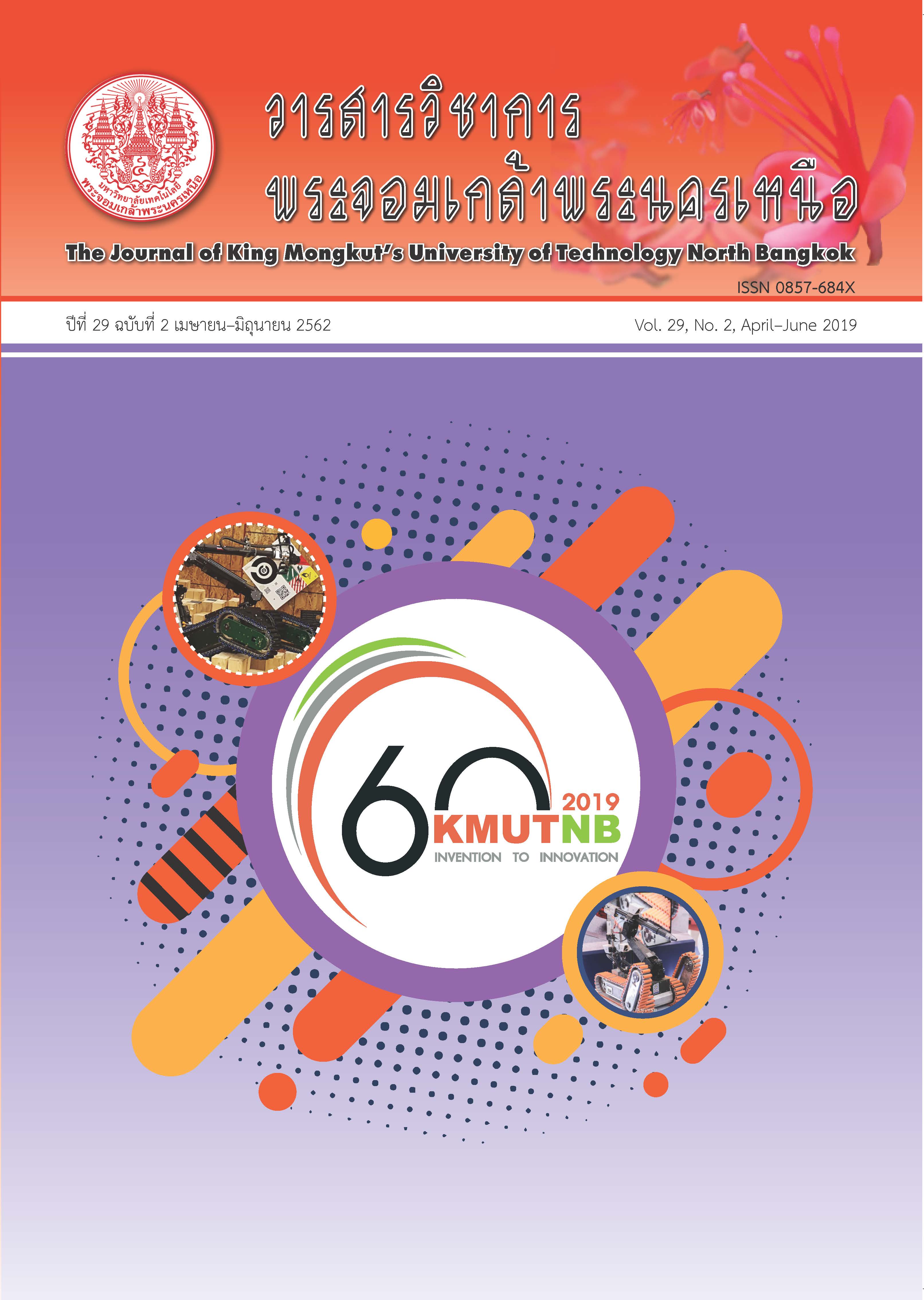การกำจัดโปรตีนจากเปลือกกุ้งด้วยเอนไซม์ปาเปนและฤทธิ์ยับยั้งเชื้อรา Fusarium oxysporum ของไคโตซาน
Main Article Content
บทคัดย่อ
ไคโตซานเป็นอนุพันธ์ของไคตินที่ได้จากการกำจัดหมู่อะซิติลซึ่งถูกนำมาใช้ประโยชน์ในด้านต่างๆ อย่างแพร่หลาย รวมถึงการยับยั้งเชื้อราที่ก่อโรคพืชเพื่อทดแทนการใช้สารเคมี งานวิจัยนี้เริ่มด้วยการเตรียมไคตินด้วยวิธีทางชีวภาพในขั้นตอนกำจัดโปรตีนเนื่องจากเป็นวิธีที่อันตรายน้อยกว่าการใช้สารเคมี และยังได้ไฮโดรไลเซตโปรตีนที่ไม่มีสารเคมีปนเปื้อนซึ่งสามารถใช้เป็นแหล่งอาหารเสริมโปรตีนของสัตว์ได้ วัตถุประสงค์ของงานวิจัยคือหาสภาวะที่เหมาะสมในการกำจัดโปรตีนจากเปลือกกุ้งโดยใช้เอนไซม์ปาเปนเกรดการค้า และนำไคตินที่ได้มาเตรียมเป็นไคโตซานเพื่อนำไคโตซานมาทดสอบฤทธิ์ยับยั้งเชื้อรา F. oxysporum ซึ่งเป็นสาเหตุของโรคเหี่ยวในพืชหลายชนิด ผลการวิจัยพบว่าสภาวะที่เหมาะสมในการกำจัดโปรตีนคือ ที่พีเอช 8.0 อุณหภูมิ 40°ซ อัตราส่วนระหว่างเปลือกกุ้งต่อปริมาณเอนไซม์เท่ากับ 1 กรัม : 1 ยูนิต เมื่อใช้เวลา 60 นาที ซึ่งให้ค่าร้อยละการกำจัดโปรตีนและแร่ธาตุเท่ากับ 63.54 ± 0.0171% และ 45.98% ตามลำดับ ไคโตซานมีฤทธิ์ยับยั้งการเจริญเติบโตของเชื้อรา F. oxysporum โดยมีค่า IC50 เท่ากับ 0.762%w/v การวิจัยครั้งนี้ทำให้ได้สภาวะที่เหมาะสมสำหรับการกำจัดโปรตีนจากเปลือกกุ้งโดยใช้เอนไซม์ปาเปน และได้ไคโตซานซึ่งเป็นตัวยับยั้งเชื้อรา F. oxysporum ที่ดี
Article Details
บทความที่ลงตีพิมพ์เป็นข้อคิดเห็นของผู้เขียนเท่านั้น
ผู้เขียนจะต้องเป็นผู้รับผิดชอบต่อผลทางกฎหมายใดๆ ที่อาจเกิดขึ้นจากบทความนั้น
เอกสารอ้างอิง
[2] S. kongthong, “Chitin-chitosan,” Journal of Industrial Education, vol. 3, no. 1, pp. 1–7, 2009.
[3] P. K. Dutta, J. Dutta, and V. S. Tripathi, “Chitin and chitosan: Chemistry, properties and applications,” Journal of Scientific and Industrial Research, vol. 63, pp. 20–31, 2004.
[4] S. Pokhrel, P. NathYadav, and R. Adhikari, “Applications of chitin and chitosan in industry and medical science: A review,” Nepal Journal of Science and Technology, vol. 16, no. 1, pp. 99–104, 2015.
[5] I. Younes, S. Hajji, V. Frachet, M. Rinaudo, K. Jelloulia, and M. Nasria, “Chitin extraction from shrimp shell using enzymatic treatment, antitumor, antioxidant and antimicrobial activities of chitosan,” International Journal of Biological Macromolecules, vol. 69, pp. 489–498, 2014.
[6] M. S. Benhabiles, R. Salah, H. Lounici, N. Drouiche, M. F. A. Goosen, and N. Mameri, “Antibacterial activity of chitin, chitosan and its oligomers prepared from shrimp shell waste,” Food Hydrocolloids, vol. 29, pp. 48–56, 2012.
[7] S. Bautista-Baños and M. Hernández-López, “Growth inhibition of selected fungi by chitosan and plant extracts,” Maxical Journal of Phytopatology, vol. 22, pp. 178–186, 2004.
[8] A. E. Hadrami, L. R. Adam, I. E. Hadrami, and F. Daayf, “Chitosan in plant protection,” Marine Drugs, vol. 8, pp. 968–987, 2010.
[9] Department of Argiculture. (2016, Febuary). Fusarium Oxysporum, cause of Fusarium wilt in plants. Department of Argiculture. Bangkok, Thailand [Online] Available: http://www.doa.go.th/share/attachment.php?aid=1213
[10] N. Benhamou, “Ultrastructure and cytochemical aspects of chitosan on Fusarium oxysporum f. sp. radices lycopersici, agent of tomato crow and root rot,” Phytopathology, vol. 82, pp. 1185–1193, 1992.
[11] M. Y. Al-Hetar, M. A. ZainalAbidin, M. Sariah, and M. Y. Wong, “Antifungal activity of chitosanagainst Fusarium oxysporum f. sp. Cubense,” Journal of Applied Polymer Science, vol. 120, pp. 2434–2439, 2011.
[12] A. A. Bell, J. C. Hubbard, and L. Liu, “Effects of chitin and chitosan on the incidence and severity of Fusarium yellows of celery,” Plant Disease, vol. 82. no. 3, pp. 322–328, 1998.
[13] C. J. Brine and P. R. Austin, “Chitin variability with species and method of preparation,” Comparative Biochemistry and Physiology. B, Comparative Biochemistry, vol. 69, no. 2, pp. 283–286, 1981.
[14] TK. Sini, S. Santhosh, and P. T. Mathew, “Study on the production of chitin and chitosan from shrimp shell by using Bacillus subtilis fermentation,” Carbohydrate Research, vol. 342, no. 16, pp. 2423–2429, 2007.
[15] I. Younes, O. Ghorbel-Bellaaj, R. Nasri, M. Chaabouni, M. Rinaudo, and M. Nasri, “Chitin and chitosan preparation from shrimp shells using optimized enzymatic deproteinization,” Process Biochemistry, vol. 47, no. 12, pp. 2032–2039, 2012.
[16] I. Younesa, S. Hajji, M. Rinaudo, M. Chaabouni, K. Jellouli, and M. Nasri, “Optimization of proteins and minerals removal from shrimp shells to produce highly acetylated chitin,” International Journal of Biological Macromolecules, vol. 84, pp. 246–253, 2016.
[17] H. He, X. Chen, C. Sun, Y. Zhang, and P. Gao, “Preparation and functional evaluation ofoligopeptide-enriched hydrolysate from shrimp (Acetes chinensis) treated with crude protease from Bacillus sp. SM98011,” Bioresource Technology, vol. 97, no. 3, pp. 385–390, 2006.
[18] H. D. Holanda and F. Netto, “Recovery of components from shrimp (Xiphopenaeus kroyeri) processing waste by enzymatic hydrolysis,” Journal of Food Science, vol. 71, no. 5, pp. 298–303, 2006.
[19] J. G. dos Santos Aguilar and H. H. Sato, “Microbial proteases: Production and application in obtaining proteinhydrolysates,” Food Research International, vol. 103, pp. 253–262, 2018.
[20] G. H. Jo, R. D. Park, and W. J. Jung, “Enzymatic production of chitin from crustacean shell waste,” in Chitin, Chitosan, Oligosaccharides and Their Derivatives, London: CRC Press, Taylor & Francis Group, 2011, pp. 37–45.
[21] C. Cupp-Enyard, “Sigma’s non-specific protease activity assay-casein as a substrate,” Journal of Visualized Experiments, vol. 19, pp. 899, 2008.
[22] Y. Rohyami, R. B. Istiningrum, and I. Sulistyaningrum, “Preparation of chitin from shrimp shells by papain latex (Carica papaya),” in proceeding of International Conference on Research, Implementation and Education of Mathematics and Sciences, Yogyakarta State University, 2014, pp. C259–C265.
[23] A. Gopalakannan, G. Indra Jasmine, S. A. Shanmugam, and G. Sugumar, “Application of proteolytic enzyme, papain for the production of chitin and chitosan from shrimp waste,” Journal of the Marine Biological Association of India, vol. 42, pp. 167–172, 2000.
[24] C. Gartner, C. A. Pelaez, and B. L. Lopez, “Characterization of chitin and chitosan extracted from shrimp shells by two methods,” e-Polymers, vol. 10, no. 1, pp. 1–16, 2010.
[25] H. Fanglian, “Bradford protein assay,” Bioprotocol, vol. 1, no. 6, 2011.
[26] S. Khantaphant and S. Akkarachaneeyakorn, “Comparative study on properties of chitosan from raw and cooked shrimp shell and the use as clarifying agent in apple juice,” The Journal of Applied Science, vol. 16, no. 1, pp. 74–86, 2017.
[27] S. Hajji, O. Ghorbel-Bellaaj, I. Younes, K. Jellouli, and M. Nasri, “Chitin extraction from crab shells by Bacillus bacteria. Biologicalactivities of fermented crab supernatants,” International Journal of Biological Macromolecules, vol. 79, pp. 167–173, 2015.
[28] P. Srinivas, V. Ratan, P. Narayan Reddy, and G. B. Madhavi, “In vitro antifungal efficacies of aqueous extract of fungicide, biocontrol agents and plant extracts against rice sheath blight pathogen Rhizoctonia Solani,” International Journal of Applied Biology and Pharmaceutical Technology, vol. 5, no. 1, pp. 122–126, 2014.
[29] F. A. Bettelheim, W. H. Brown, M. K. Campbell, M. O. Farrell, and O. J. Torres, Introduction to General, Organic, and Biochemistry, 10th ed. United States of America: Wiley, 2011.

